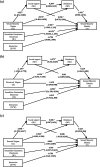Chained multimediator model of sexual orientation disclosure, sexual minority stigma, sexual minority identity, social support, and resilience among ymsms
- PMID: 35449098
- PMCID: PMC9026989
- DOI: 10.1186/s12889-022-13231-8
Chained multimediator model of sexual orientation disclosure, sexual minority stigma, sexual minority identity, social support, and resilience among ymsms
Abstract
Introduction: This study aimed to investigate sexual orientation disclosure and mental health among young men who have sex with men (YMSMs). To this end, we constructed a chained multimediator model of sexual minority stigma, sexual minority identity, social support, and resilience, with the moderator of sexual orientation disclosure.
Methods: We conducted a cross-sectional survey of 345 YMSMs in Nanning, China. Bivariate analysis was used to evaluate factors associated with sexual orientation disclosure. Sexual minority stigma was used to predict identity, with social support as the step 1 mediator and resilience as the step 2 mediator. Sexual minority identity was analyzed using a chained moderated mediation model; sexual orientation disclosure was included as a moderator in all models to control its confounding effect.
Results: The average age of YMSMs was 20.0 ± 1.3 years. Bivariate analysis indicated that YMSMs who disclosed sexual orientation may have experienced less stigma (15.49 ± 3.02 vs 16.21 ± 2.74), obtained more social support (65.98 ± 11.18 vs 63.19 ± 11.13), had strong psychological resilience (37.40 ± 8.57 vs 35.39 ± 7.73), and had a more positive self-identity (104.12 ± 21.10 vs 95.35 ± 16.67); differences between subgroups were statistically significant (p < 0.05). Sexual minority stigma, perceived stigma, and enacted stigma were significantly associated with social support and resilience. The association between sexual minority stigma and sexual minority identity was significantly mediated by social support (indirect effect [95% CI] = - 3.307 [- 4.782, - 1.907]). Resilience significantly mediated the same association for identity (- 2.544 [- 4.052, - 1.114]). The chained relationship from sexual minority stigma to social support, resilience, and identity was also significant, with an indirect effect of - 0.404 [- 0.621, - 0.249].
Conclusion: Among YMSMs in China, sexual minority stigma affects sexual minority identity through social support and resilience. Given the psychological effects of stigma, social support and resilience must be considered to better promote positive self-identity and mental health among YMSMs.
Keywords: Mediation model; Resilience; Sexual minority identity; Sexual minority stigma; Sexual orientation disclosure; Social support; YMSM.
© 2022. The Author(s).
Conflict of interest statement
The authors have no conflicts of interest to declare.
Figures



Similar articles
-
Associations between sexual identity stigma and positive sexual identity, and depression among men who have sex with men in China: A mediation analysis using structural equation modelling.Ann Epidemiol. 2024 Aug;96:32-39. doi: 10.1016/j.annepidem.2024.05.010. Epub 2024 Jun 1. Ann Epidemiol. 2024. PMID: 38830488
-
Understanding How Sexual and Gender Minority Stigmas Influence Depression Among Trans Women and Men Who Have Sex with Men in India.LGBT Health. 2017 Jun;4(3):217-226. doi: 10.1089/lgbt.2016.0082. Epub 2017 Apr 19. LGBT Health. 2017. PMID: 28422615
-
Association between enacted stigma, internalized stigma, resilience, and depressive symptoms among young men who have sex with men in China: a moderated mediation model analysis.Ann Epidemiol. 2021 Apr;56:1-8. doi: 10.1016/j.annepidem.2021.01.001. Epub 2021 Jan 7. Ann Epidemiol. 2021. PMID: 33422600
-
Rethinking minority stress: A social safety perspective on the health effects of stigma in sexually-diverse and gender-diverse populations.Neurosci Biobehav Rev. 2022 Jul;138:104720. doi: 10.1016/j.neubiorev.2022.104720. Epub 2022 Jun 2. Neurosci Biobehav Rev. 2022. PMID: 35662651 Review.
-
A systematic review of stigma in sexual and gender minority health interventions.Transl Behav Med. 2020 Oct 12;10(5):1200-1210. doi: 10.1093/tbm/ibz200. Transl Behav Med. 2020. PMID: 33044540 Free PMC article.
Cited by
-
Psychosocial impact and stigma on men who have sex with men due to monkeypox.Front Public Health. 2025 Mar 19;13:1479680. doi: 10.3389/fpubh.2025.1479680. eCollection 2025. Front Public Health. 2025. PMID: 40177086 Free PMC article.
-
A Study of the Relationship between Men Who Have Sex with Men Stigma and Depression: A Moderated Mediation Model.Healthcare (Basel). 2023 Oct 29;11(21):2849. doi: 10.3390/healthcare11212849. Healthcare (Basel). 2023. PMID: 37957994 Free PMC article.
References
-
- Tamagawa M. Coming Out of the Closet in Japan: An Exploratory Sociological Study. J GLBT Fam Stud. 2017;14(5):488–518. doi: 10.1080/1550428X.2017.1338172. - DOI
Publication types
MeSH terms
LinkOut - more resources
Full Text Sources

